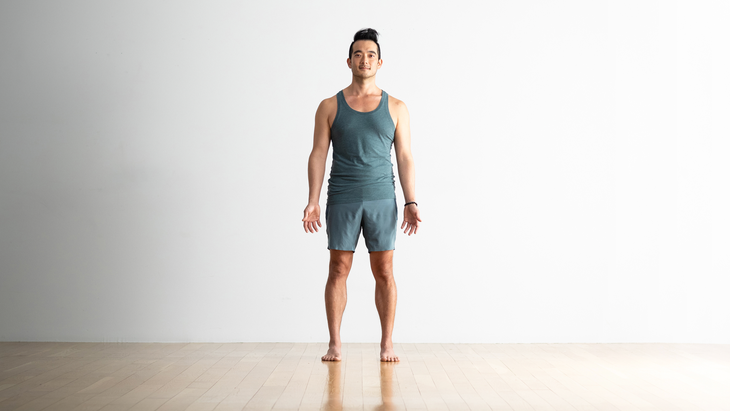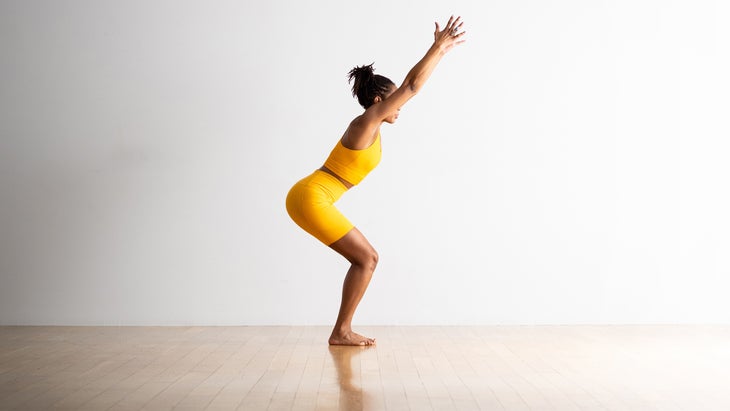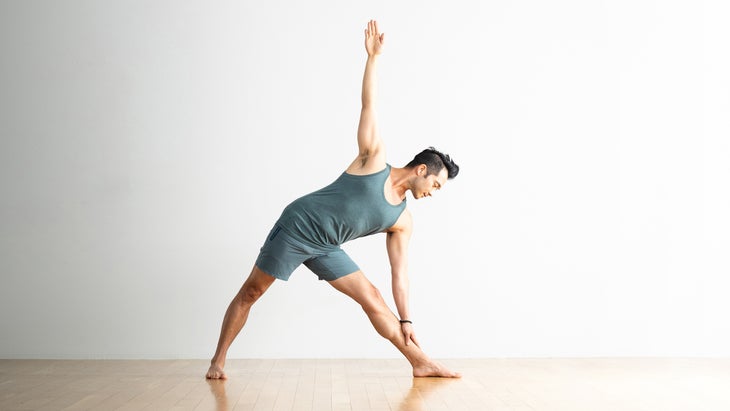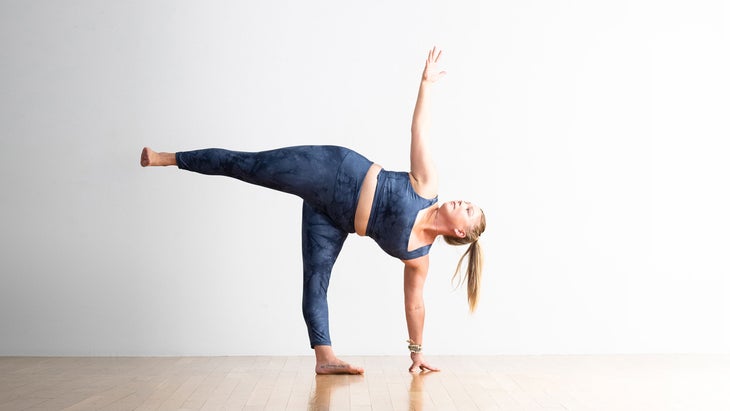“], “filter”: { “nextExceptions”: “img, blockquote, div”, “nextContainsExceptions”: “img, blockquote, a.btn, a.o-button”} }”>
Heading out the door? Read this article on the new Outside+ app available now on iOS devices for members!
>”,”name”:”in-content-cta”,”type”:”link”}}”>Download the app.
Early in my teaching career, I fell into what I call “The Novelty Trap.” Each class had to be a masterpiece, a completely unique sequence of poses and practices that I had labored to sequence, for me to feel that I had satisfied my role as yoga teacher.
It wasn’t long before I would find myself staring at a blank sheet of paper with what can only be called dread, certain I didn’t have a single novel idea in me for sequencing. I had used every pose variation in my teacher training textbook, repeated every fancy transition I had experienced, and even made up several of my own. Class planning became such a stressor for me that I would find any excuse at all to delay it, sitting down with that blank paper later and later the night before teaching, as if exhaustion and desperation would somehow summon creativity.
Then one day I was scheduled to teach back-to-back classes. My habit, in this situation, was simply to repeat a variation on my carefully crafted sequence for the second class. I figured I would peak one pose earlier, slip in an additional pose during the cool down, or keep the same lower body positions but vary the arms. But after the first class, one student cheerfully told me she had so appreciated the first class that she intended to stay for a second. I was horrified. With no time to come up with a new sequence from scratch, I admitted to the student that I had planned to teach the same exact poses.
To my amazement, she was not only willing but happy to stay despite the repetition. In that moment, I began to understand that, as a student, I didn’t need or even want every part of each class to be novel. As much as most of us like to learn on the mat, we also like to return to poses and practices over and over again.
As a teacher, I had become so focused on curating an experience that focused on different poses and variations and transitions that I lost my understanding of why my students actually attended class, which was simply to come away feeling better in body and mind.
That was the beginning of a new approach I took to sequencing, one in which I was much more willing to embrace the familiar. I no longer planned each class with a blank piece of paper and a feeling of dread. I found that I could teach the exact same sequence of poses and vary the pace and rhythm in ways that led to an entirely different experience for students.
How to Teach the Same Exact Yoga Sequence…Differently
If you’ve also fallen into The Novelty Trap in your teaching or home practice, here are five ways you can move through the same standing yoga sequence of poses while emphasizing different elements of the practice. You can do this with any sequence of poses that you prefer. I’ve offered a short sequence of eight standing poses simply as en example. Let’s compare and contrast.
1. One and Done
In the One and Done approach, you move through the sequence of poses once, staying strong and steady in each pose for several breaths. The major feature of this approach is a rather luxurious amount of time in each pose, which can be channeled into precision in cueing and body alignment. It allows for quiet and space in between verbal cues and cultivates endurance and slow-burn strengthening. It’s a strong shorter practice on its own or can be incorporated into a slow class style.
On the down side, time in a pose can be its own challenge—especially if that pose demands a high level of strength or stability or is in a series of poses that tax the same region of the body. That can make this approach difficult for beginners, who are yet to build the required strength, stability or endurance. It can also be frustrating for students who have come to class looking for a more mellow experience or to boost heart-rate.
One way to balance static time and movement using this strategy is to practice your slow and steady sequence on the first side and then offer a faster-moving flow that is simple or more familiar (like a Sun Salutation) before taking students through the second side.
How to: Following is how to teach in One and Done style using a sequence of poses as an example. Substitute your preferred sequence, preferably one that you did not dread creating.

Start in Mountain Pose (Tadasana).

From Mountain, bend your knees and come into Chair Pose (Utkatasana). Shift your weight onto your right foot and step your left foot back as if you were coming into High Lunge but keep your torso tilted forward.

Pivot your back heel down and turn your chest to face the left long side of the mat as you come into Extended Side Angle (Utthita Parsvakonasana).

Press into the ball of your front foot and straighten your front leg to come into Triangle (Utthita Trikonasana).

Shift your weight forward into your front foot and lift your back leg for a version of Half Moon (Ardha Chandrasana) in which your bottom hand might hover above the mat.

Step your lifted left leg forward next to your right, turn to face the front of the mat, and stand tall as you return to Mountain before practicing the sequence on your other side.
2. Free Flow
If the One and Done approach feels a little slow and precise for you, imagine free flowing to a new pose with each phase of the breath. This approach, most appropriate to a vinyasa or flow class, clearly prioritizes movement over precision or endurance and build warmths, boosts heart rate, and fosters rhythm and momentum.
Every plus comes with a minus, and since free flow leaves little time for detailed alignment cues or offering options or props, beginners could easily feel confused or overwhelmed. This approach works best for experienced students who are already familiar with the poses in the sequence. Even experienced students could lose sight of details of alignment or become bored with the flow if it’s repeated too many times without added embellishment.
One way to reduce that propensity is to vary the focus of your cues each time through the flow, like highlighting foot position the first time through, hips and core the second time through, focusing on arms and shoulders (even adding arm variations) the third time through, and cueing more subtly to energetic effects or even setting students loose to flow without cueing a final time through.
How to: Using our example sequence, you’d inhale from Mountain to Chair Pose, exhale to Leaning Forward Lunge, inhale to Extended Side Angle, exhale to Triangle, inhale to Half Moon, and exhale to step forward to Mountain. You might pause there for a breath to reset before moving to your second side.
3. Start Slow, Build to Flow
There’s a way to build to a fast flow that engages students’ interest but balances the benefits of the first two approaches. Namely, start slow before you build speed in a flow.
In this approach, you run through your sequence slowly once or twice, taking time in each pose for key cues on engagement or alignment or demonstration of appropriate variations or prop options, then repeat it, increasing your pace until students flow with the breath.
This strategy is appropriate for vinyasa or flow classes and provides better support for newer students while giving more experienced students pointers they can focus on and refine. There’s a feeling of balance between movement and time holding still.
On the downside, this strategy takes time so it doesn’t suit shorter practices.
How to: Using our example sequence, you might stay in each pose for 3 to 5 breaths and familiarize yourself with the alignment during the first round, then repeat the sequence a second time holding each pose for just 2 breaths, and then repeat the sequence a third time by inhaling from Mountain to Chair Pose, exhaling to Lunge, inhaling to Extended Side Angle, exhaling to Triangle, inhaling to Half Moon, and exhaling back to Mountain.
4. Step by Step
When a slow pace feels too static, you could instead build a sequence step by step, adding a pose or two at a time and alternating between them with the breath to add a feeling of flow.
This approach focuses on transitions between poses, which often get less attention than they need and deserve, and builds cumulative warmth without the potential monotony of repeating the exact same flow. It gives students a little more time to become familiar with key aspects of each pose and the transition in between them without making them hold still, though you could tailor this approach to beginners or slow and steady classes by taking a few breaths to settle in the first time you practice each pose.
How to: Using our example sequence and the rhythm of the breath, start in Mountain, inhale into Chair, and exhale to stand in Mountain four times. After your fifth inhalation to Chair, you’d exhale to transition back to Lunge, inhale forward to Chair and exhale back to Lunge four more times. Then on the fifth inhalation, you’d pivot to Extended Side Angle and so on until finishing the entire flow on your right side, ready to repeat it on your left.
You can also play with the duration and intensity of this approach by increasing or decreasing the number of breaths in each pose pair, though it does take practice to count breaths as well as offering key cues to anchor each pose or transition. When crafting a step-by-step sequence, you also need to be mindful of the potential for cumulative fatigue in key muscle groups (namely, the quads).
5. Ladder Flow
A ladder flow builds one pose at a time and then retraces its steps back to the start of the sequence. As earlier poses become more familiar a feeling of rhythm and flow can build, but this sequencing strategy does require the students’ full attention, especially early on – both to remember the flow of poses, and to master the novelty of familiar transitions done in reverse order. This can be both a pro and a con, drowning out distractions to anchoring mind to body, but potentially asking too much of a sluggish brain early in the morning or a tired one after a long work day. It works best in vinyasa or flow classes for more experienced students who are familiar enough with the poses in your sequence to have attention and agility to spare.
How to: Using our example sequence, that could look like the following, perhaps with a pause for a consolidating breath each time in Mountain Pose.
Round One
Inhale from Mountain to Chair Pose, exhale to Mountain Pose.
Round Two
Inhale from Mountain to Chair Pose, exhale and step back to Lunge, inhale forward to Chair pose, exhale Mountain, inhale to Chair, exhale to step back to left side Lunge, inhale to Chair and exhale to Mountain.
Round Three
Inhale from Mountain to Chair, exhale to right side Lunge, inhale to ground your back heel and open to right Side Angle, exhale and pivot back to right side Lunge, inhale forward to Chair, exhale to Mountain, inhale to Chair, exhale to left side Lunge, inhale to ground your back heel and open to left Side Angle, exhale to pivot back to left side Lunge, inhale to Chair, and exhale to Mountain.
Round Four
Inhale from Mountain to Chair, exhale to right side Lunge, inhale to right Side Angle, exhale to straighten your front leg for Triangle, inhale bend your front knee for Side Angle, exhale to right Lunge, inhale forward to Chair Pose, exhale Mountain, inhale to Chair, exhale to left side Lunge, inhale to left Side Angle, exhale and straighten your front leg for left side Triangle, inhale to bend your front knee for Side Angle, exhale to left side Lunge, inhale to Chair, and exhale to Mountain.
And so on until the sequence is completed.
And there you have it—five possible ways to escape The Novelty Trap. If you ever find yourself staring at a blank piece of paper or screen, desperately trying to come up with something fancy and new for your next sequence, it might be time to rethink your approach. Rather than placing novelty on the pedestal, know that the exact same standing sequence can create a completely different experience, depending on how you move help your students move through it.


